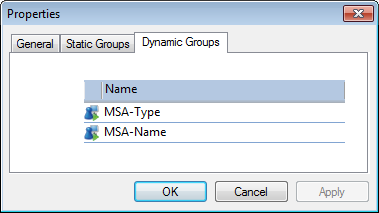Grouping of Users and Computers
The target of an assignment is always an individual computer. However, the assignment process can become much more efficient and productive by creating groups of users and computers. The packages you want to distribute are not only assigned to an individual computer but at the same time to a number of computers or users, which have been grouped by specific criteria. This allows you to set up standards that make daily operations much more convenient.
The organization tree supports two methods of grouping:
- The "fixed
position" definition of computers/users
This type of grouping assigns the computer/user a fixed position within the structure: Each computer/user can only be in one container. - Grouping
together similar objects (computer/user group)
This involves grouping computers or users together in groups that have shared properties. These might be the type and name of computers as well as project associations, job profiles, and user classes.
There are three types of groups in the organization tree:
- Static
groups: You may assign any type of computer
 or user
or user
 to
this group manually, for example
if you want to specify exceptions or special cases. This allows you to
specify rules for assigning software to an installation target on a higher
hierarchical level in the organization tree and then to implement exceptions
to the rule by applying deny policies to the static group.
to
this group manually, for example
if you want to specify exceptions or special cases. This allows you to
specify rules for assigning software to an installation target on a higher
hierarchical level in the organization tree and then to implement exceptions
to the rule by applying deny policies to the static group. - Dynamic
groups: Combine similar computers
 or users
or users  at runtime (dynamic) according to defined filter
criteria. Dynamic
groups may be nested on five levels. The filter criteria of nested dynamic
groups are linked by an AND. The LDAP filter length is limited to 4000
characters per filter.
at runtime (dynamic) according to defined filter
criteria. Dynamic
groups may be nested on five levels. The filter criteria of nested dynamic
groups are linked by an AND. The LDAP filter length is limited to 4000
characters per filter. - External
groups
 : May contain users and computers that are imported
from an organization directory (e.g. Active Directory).
: May contain users and computers that are imported
from an organization directory (e.g. Active Directory).
Static and dynamic groups can contain either only computers
![]() or only users
or only users ![]() . External groups from an
Active Directory that already contain both users and computers are taken
over into the organization tree without modifications.
. External groups from an
Active Directory that already contain both users and computers are taken
over into the organization tree without modifications.
Groups and Organization Containers
Groups can only contain computers or users that belong to the same organization container (domain or OU) than the actual group or a child group. In fact, groups do not serve as organization containers but as "filters" for organization containers.
Membership in a Dynamic Group
If group objects are hidden from the organizational tree via the  Show / Hide groups icon, the members of a dynamic group cannot be displayed in the DSMC's object window. They will be displayed, however, on the Dynamic Groups tab of a group's Properties dialog.
Show / Hide groups icon, the members of a dynamic group cannot be displayed in the DSMC's object window. They will be displayed, however, on the Dynamic Groups tab of a group's Properties dialog.
The Properties context menu entry of a computer object shows the dynamic group(s) the computer it is a member of.
